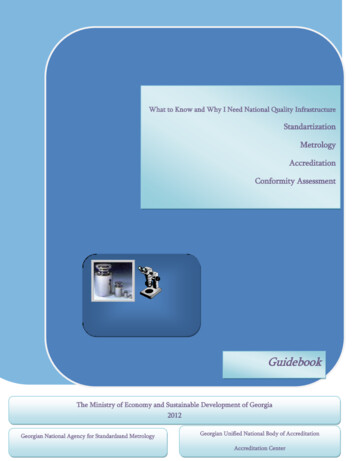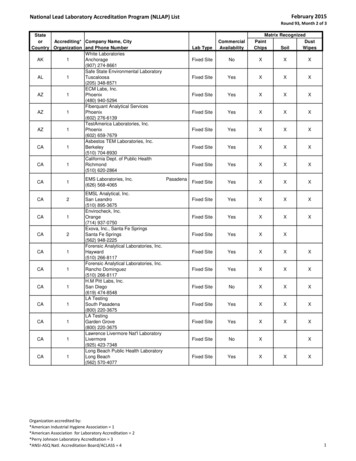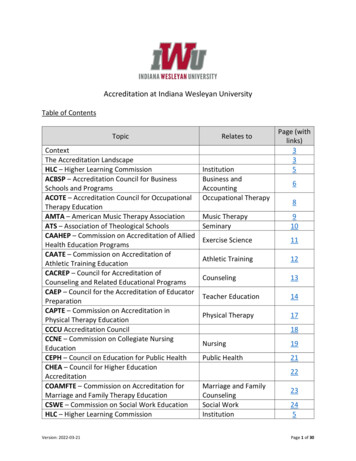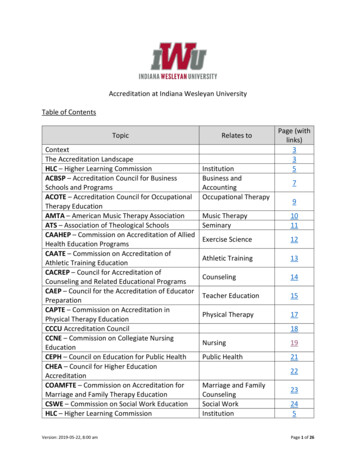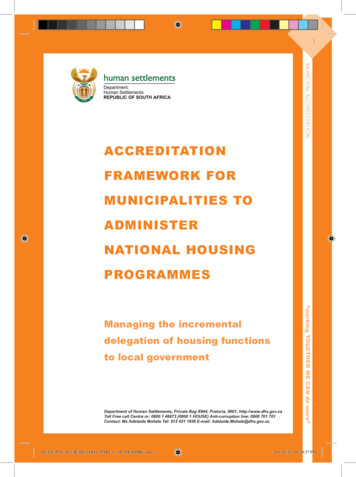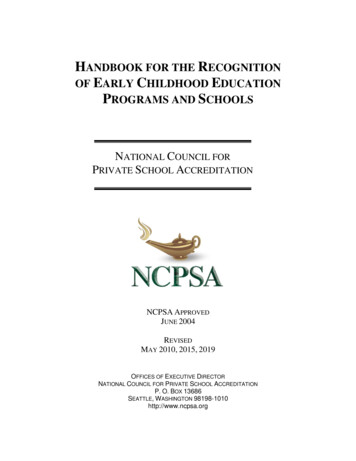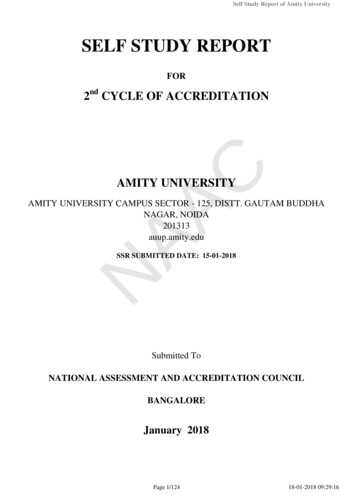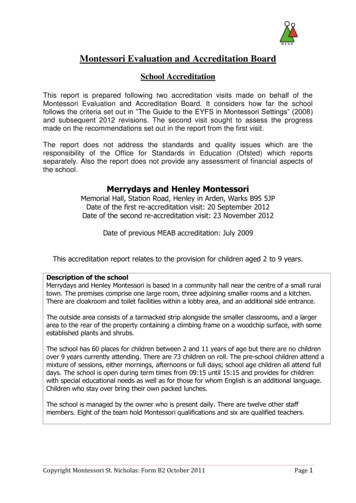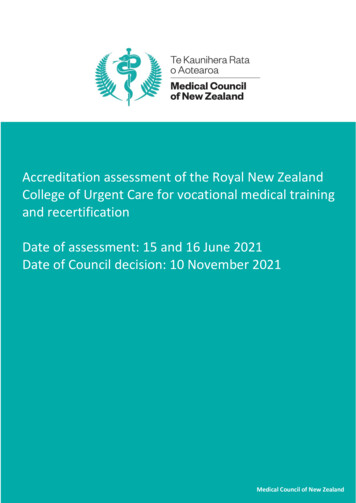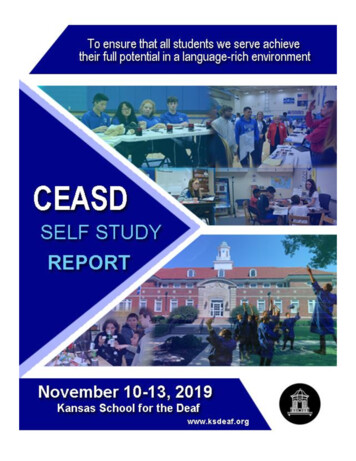
Transcription
CEASD Accreditation Self-Study ReportConference of Educational Administrators of Schools andPrograms for the Deaf (CEASD) Self-Study AccreditationReport for Kansas School for the DeafSteering Committee/School Improvement TeamStandard Chairs:Standard 1 – Larry Finn, Curriculum and Assessment CoordinatorStandard 2 – Luanne Barron, SuperintendentStandard 3 – Luanne Barron, SuperintendentLarry Finn, Curriculum and Assessment CoordinatorJoan Macy, Outreach CoordinatorStandard 4 – Jeanette Magathan, Director of FinanceStandard 5 – John Martello, COO of OperationsStandard 6 – Luanne Barron, SuperintendentStandard 7 – Joan Macy, Outreach CoordinatorJohn Martello, COO of OperationsStandard 8 – Larry Finn, Curriculum and Assessment CoordinatorKevin Milner, Secondary Head TeacherPetra Horn-Marsh, Elementary Head TeacherStandard 9 – Larry Finn, Curriculum and Assessment CoordinatorKevin Milner, Secondary Head TeacherPetra Horn-Marsh, Elementary Head TeacherStandard 10 – Joan Macy, Outreach CoordinatorMary Hughes, Dean of Student LifeKelly Grove, Transition FacilitatorJohn Martello, COO of OperationsStandard 11 – Mary Hughes, Dean of Student LifeDean Muszynski, Activities DirectorLarry Finn, Curriculum and Assessment CoordinatorStandard 12 – Joe Oborny, Instructional Technology CoordinatorBeth Beadle, LibrarianKansas School for the Deafi
CEASD Accreditation Self-Study ReportKSD Leadership Team (KSDLT):Luanne Barron, SuperintendentJohn Martello, COO of OperationsJeanette Magathan, Director of FinanceTeresa Chandler, Director of Human ResourcesJoan Macy, Outreach CoordinatorMary Hughes, Dean of Student LifeKevin Milner, Secondary Head TeacherMolly Rothwell, Elementary Head TeacherLarry Finn, Curriculum and Assessment CoordinatorJoe Oborny, Instructional Technology CoordinatorJay Ray, Operations MangerDean Muszynski, Activities CoordinatorTessa Adcock, DieticianSchool Improvement TeamsSecondaryJoelle Allen, Classroom TeacherNancy Frazier, Classroom TeacherAmanda Harris, Classroom TeacherJanna Wiesner, School Social WorkerJennifer Kucinski, School PsychologistMike Wiesner, Classroom TeacherKevin Milner, Secondary Head TeacherSally Luton, Classroom TeacherElementaryMolly Rothwell, Elementary Head TeacherLeslie Caldwell, SLPDaniel Allen, Classroom TeacherKester Horn-Marsh, Bilingual CoordinatorKansas School for the Deafii
CEASD Accreditation Self-Study ReportTable of ContentsCONTEXT OF KANSAS SCHOOL FOR THE DEAF . 1ACCREDITATION PROCESS. 1COMMUNITY PROFILE. 2SCHOOL PROFILE . 11STUDENT ACHIEVEMENT PROFILE . 26MISSION/VISION/DIVERSITY/CORE VALUES STATEMENTS . 64ANALYSIS OF STAKEHOLDERS SURVEYS . 65Standard 1: Philosophy/Mission. 66Standard 2: Governance and Leadership . 71Standard 3: School Improvement Planning and Viability . 80Standard 4: Finances . 96Standard 5: Facilities. 102Standard 6: School Climate and Organization . 107Standard 7: Health and Safety . 121Standard 8: Educational Program . 129Standard 9: Assessment and Evidence of Student Learning . 147Standard 10: Student Services . 159Standard 11: Student Life, Student Activities & Residential . 169Standard 12: Learning Resources & Information Technology . 180Kansas School for the Deafiii
CEASD Accreditation Self-Study ReportACRONYMSAMOSS – Academic Measures of Student SuccessD/HH – Deaf/Hard of HearingECC – Early Childhood CenterELA – English Language ArtsELL – English Language Learners of Other LanguageELP – English Language ProficiencyESOL – English Speakers of Other LanguageFERPA – Family Educational Rights and Privacy ActJCCC – Johnson County Community CollegeKAD – Kansas Association for the DeafKASB – Kansas Association of School BoardsK-CAP – Kansas--Community Action PlanKCK – Kansas City, KansasKDHE – Kansas Department of Health and EnvironmentKSBE – Kansas State Board of EducationKSD – Kansas School for the DeafKSD-KNEA – Kansas School for the Deaf--Kansas National Education AssociationKSDE – Kansas State Department of EducationKSDLT – Kansas School for the Deaf Leadership TeamKSSB – Kansas State School for the BlindKSTAR – Kansas Student Transition & Academic ReadinessLAP—DHH – Language Assessment Program for Deaf and Hard of HearingMDHAC – Museum of Deaf History, Arts and CultureMNU – MidAmerica Nazarene UniversityPBIS – Positive Behavioral Intervention and SupportsPD – Professional DevelopmentPRIDE – Preparation, Respect, Independence, Diversity, EffortSL – Student LifeTASN – Technical Assistance System NetworkTOD – Teacher of the DeafKansas School for the Deafiv
CEASD Accreditation Self-Study ReportContext of the SchoolKansas School for the Deaf1
CEASD Accreditation Self-Study ReportCONTEXT OF KANSAS SCHOOL FOR THE DEAFACCREDITATION PROCESSThe Conference of Educational Administrators of Schools and Programs for the Deaf(CEASD) accreditation process has been fully embraced and implemented by KSD. TheKansas State Department of Education (KSDE) has agreed that KSD can use the CEASDaccreditation process as long as it covers the hallmarks of the Kansas Education SystemsAccreditation (KESA). This process has been an effective tool for us to improve instruction,to improve our relationship with our constituents, and to measurably demonstrate oureducational effectiveness. The CEASD accreditation process provides an opportunity forprofessionals to work together for the improvement of KSD programs. Because so manystudents come to KSD so far behind academically, it is extremely difficult to overcome theselearning deficits until we can address communication and language which are required to attainliteracy as early as possible.This is the last year of a five-year cycle for the CEASD accreditation process. Many servicessuch as training programs for teachers of the deaf, outreach services, parent support, andprofessional development have been implemented for special and general education teachersto ensure students who are D/HH receive a quality education. The process of accreditationallows KSD to build true capacity to improve student learning and make continuous schoolimprovement a reality.KSD aims to strengthen educational quality and accountability through the KSDE SpecialEducation Kansas Integrated Accountability System (KIAS) and Kansas Education SystemsAccreditation (KESA). Five years ago, the process of accreditation was implemented throughthe CEASD because of their knowledge in the field of deaf education. The State of Kansas hasadopted a new state accreditation process which is similar in many ways to that of CEASD.After reviewing the KESA requirements, a crosscheck with CEASD was created and foundboth systems matched up well. KSDE agreed to allow us to use CEASD as our stateaccreditation process. In order to align the requirements with KESA, the CEASD accreditationvisit will be held in November 2019. While not technically a joint accreditation visit, some ofthe unique state requirements will be included as part of our CEASD Self-Study.KSD used a collaborative process to develop the self-study. Under the direction of thesuperintendent and the Kansas School for the Deaf Leadership Team (KSDLT), the twelvestandards were assigned to different chairpersons. The chairs then formed committees andbegan the process of collecting feedback from stakeholders via surveys and large/small groupmeetings. The chairs reported their progress to the superintendent and the KSDLT at themonthly meeting. Each standard chair completed the ratings, narratives and strengths/areas toimprove. Their reports were reviewed by the superintendent and the KSDLT then entered intothe self-study document.Kansas School for the DeafPage 1 of 194
CEASD Accreditation Self-Study ReportCOMMUNITY PROFILEEarly History of OlatheThe town of Olathe was founded in 1857, getting its name from the Shawnee word for“beautiful”. After being the site of much activity during the America Civil War, Olathe wenton to become a major stop on the California Trail, the Oregon Trail, and the Santa Fe Trail.Catering to travelers moving along these paths became the primary income source for localbusinesses. Once the construction of the Transcontinental Railroad saw completion, however,these westward trails lost significance, and Olathe withered into obscurity.The construction of the Interstate Highway system in the 1950s saw Olathe linked toneighboring Kansas City, resulting in tremendous residential growth and Olathe becoming partof the Kansas City metropolitan area. The 1980s saw even more of a boom in populationgrowth due to tremendous commercial development.Population GrowthIn 1900, at the turn of the century and almost 40 years after Olathe’s incorporation, thepopulation stood at 3,451. This kept relatively stagnant over the decades that followed due tothe town’s relative obscurity and insignificance.By the end of the 1940s, Olathe had seen a 6% increase in the population, bringing it up to justshy of 11,000 in 1960. This rise continued with an increase of almost 7,000 people by 1970,and an additional 19,000 people by the end of the decade.These numbers have continued to steadily rise year by year, and this growth can be mainlyattributed to the construction of the Interstate Highway, bringing Olathe’s proximity and accessto and from nearby Kansas City ever closer, and making it more accessible for surroundingtowns and cities.While Olathe’s population is just over 139,605 in 2019, some estimates peg its population at300,000 within 20 years y-file.htmlKansas School for the DeafPage 2 of 194
CEASD Accreditation Self-Study ReportThese following four charts contain education data using the latest 2017 American CommunitySurvey data.2 Figure 1 below shows the number of people aged 25 years or older who havegraduated from high school or completed their GED.(94%)Figure 2 shows the number of people aged 25 or older who have graduated from college witha Bachelor’s lathe-city-KS-Education-data.htmlKansas School for the DeafPage 3 of 194
CEASD Accreditation Self-Study ReportFigure 5 shows the percentages of those who have attained various levels of education.Figure 6 shows the percentages of those who attained higher education after graduating fromhigh school.Kansas School for the DeafPage 4 of 194
CEASD Accreditation Self-Study ReportOlathe DemographicsThe following chart shows the racial composition of Olathe, Kansas according to the 2017American Community Survey (ACA).3Native Hawaiian0.07%City of OlatheEthnicityNative American0.34%Other race1.17%Asian, 4.39%African American5.51%WhiteTwo or more races3.58%Two or more racesAfrican AmericanAsianNative HawaiianNative AmericanOther raceWhite84.94%Median Age of Olathe ResidentsMedian AgeOverall34.7Median AgeFemales35.3OverallMalesFemales3Median s/olathe-ks-population/Kansas School for the DeafPage 5 of 194
CEASD Accreditation Self-Study ReportOlathe Public Schools Student DemographicsEnrollment: 30,145 – second largest school district in KansasKansas School for the DeafPage 6 of 194
CEASD Accreditation Self-Study ReportOlathe Public Schools403635Number of Schools3025201510105511Mill CreekAlternateEducationOlathe AdvancedTechnical Center0Elementary (K-5)Middle (6-8)High (9-12)School/School LevelKansas School for the DeafPage 7 of 194
CEASD Accreditation Self-Study ReportCity of Olathe and KSD Grew Up TogetherOlathe, the home of the Kansas School for the Deaf, along with other surrounding cities is thesecond largest Deaf Community in the United States. KSD is considered the center of thiscommunity and has a long history of working with city and county officials (i.e., developmentof MOU pertaining to the provision of Kansas Senate Bill 367 and the Kansas School Safetyand Security Act).This is to acknowledge Olathe’s culture that truly embraces the Deaf and Hard of Hearing andoffers services and programs for the community. Olathe rates at the top of nearly everycategory measured, including culture, access to medical care, and community programs.Examples of the services that Olathe provides are: Olathe Medical Center provides a free 24-hour interpreter service called Hear for Youfor D/HH patients and their families. A network of 17 ASL interpreters are on call atall times to assure medical care will progress unhindered by communication problems.Olathe Medical Center patients are provided language interpretation via interpreterson-site or through Virtual Remote Interpreting services. This service also includesinterpreting services for Olathe Medical Center, Miami County Medical Center, theoffices of staff physicians, wellness programs, childbirth preparation classes andsupport groups. All five high schools in the Olathe Public School District offer American SignLanguage classes as a foreign language. The City of Olathe makes a deliberate effort to include deaf people. City Councilmeetings are interpreted. The Mayor of Olathe appoints board members to include deafrepresentatives on city committees including the Police Advisory Board and Personswith Disabilities Advisory Board. Also, the city provides free smoke detectors to deafresidents.Olathe Public Schools (USD 233)Dual PlacementBecause Olathe is a unique community that includes individuals and families who are deaf orhard-of-hearing and has been the home of KSD for over 150 years, Olathe resident studentsand students residing in the dormitory at KSD have the option of attending classes at both KSDand Olathe Public Schools (OPS) if this is determined by the IEP team to be the least restrictiveenvironment. KSD has a Memorandum of Understanding (MOU) with the Olathe SchoolsDistrict under the guidance of the Transition Facilitator at KSD and the Deaf and Hard ofHearing Consultant for the Olathe Schools. Interaction between deaf/hard of hearing studentsand hearing students in an integrated setting can be valuable, desirable and educationallyKansas School for the DeafPage 8 of 194
CEASD Accreditation Self-Study Reportappropriate. There are opportunities for a broader range of academic, vocational, and socialexperiences. The option for KSD students to take courses in the Olathe Public School Districtis determined by the student’s needs, abilities and desires with input and feedback fromclassroom teachers, the LEA, parents and school administrators. Dual placement is addressedand determined at the IEP meeting. Students interested in taking one or more classes at anOlathe public school will need to follow the policies and procedures that have been set. A copyof the Dual Placement guidelines is available upon request.Another agreement in place with USD 233 is for our students to be able to take classes at thecenter-based Olathe Advanced Technical Center (OATC). The purpose of this agreementbetween KSD and Olathe is for KSD students to have the opportunity to receive educationalservices in the areas of career and technical education. The Olathe School District isresponsible for interpreter services for students who reside within Olathe Public Schoolboundaries. KSD is responsible for interpreter services for non-Olathe students.Alumni AssociationThe KSD Alumni Association (KSDAA) continues to be a very vibrant organization thatprovides real life benefits for our students. Alumni also donate their valuable time to offercareer support to current students as well as additional funds for student needs. The purpose ofthe KSDAA is to foster a spirit of loyalty and to promote the general welfare of the school.Every year they alternatively host Hall of Fame and Distinguished Leader/Service eventswhich run concurrent with the 25th, 50th & 75th class reunions.Museum of Deaf History, Arts and Culture (MDHAC)Olathe is home to the MDHAC which is the only independently owned and public museumabout Deaf history, arts and culture in the country. It is located across the street from KSD andis the home of the Marra Museum which spotlights the rich heritage and experience of beingDeaf. The MDHAC is a non-profit foundation and they offer group tours and special events.The KSD Superintendent has a seat on the Board of Directors and KSD Endowment continuesto be the largest donor to support the museum. Our students continue to enjoy the benefits themuseum has to offer through tours, hands on activities, and volunteer opportunities.Johnson County Community CollegeTwenty minutes from KSD is the Johnson County Community College (JCCC), one of thelargest community colleges in the country. JCCC has over 19,000 students enrolled with nearly1,000 full-time faculty and 1,900 adjunct faculty and part-time staff. They offer more than 50degree and certificate programs.Kansas School for the DeafPage 9 of 194
CEASD Accreditation Self-Study ReportExamples of what they have to offer our students: Dual Credit: Our high school students, if eligible, can enroll in classes at JCCC andearn dual credit. For the fall 2019 semester, four students are enrolled in the Transitioninto Post-Secondary (T.I.P.S.) program at Johnson County Community College.T.I.P.S. is a dual credit transition class designed to teach students valuable skills for asuccessful transition to college, a training program, or the workforce upon graduation.Students learn strategies such as: using college textbooks, taking meaningful lecturenotes, integrating text and lecture information for personal study habits, preparing forand taking exams, critical thinking skills, time management principles, electroniclearning management systems, career explorations and options, and managing collegecoursework. This class exposes students to various sources of information on careerand training options and may also assist them in developing job search and employmentskills. Students earn three college credits for the T.I.P.S. class. JCCC has a long history of serving the D/HH community. Their goal is for collegestudents to gain a positive experience without any barriers. They provide an abundanceof resources to help D/HH students reach their academic goals by providing a counselorwho is proficient in ASL, 20 certified ASL interpreters, a reading education specialist,D/HH faculty and staff, public videophones across campus, personal FM systems andaccessible digital media. JCCC offers a two-year ASL/Deaf Studies program and is a feeder program to theUniversity of Kansas’ new ASL/Deaf Studies program at the Edwards Campus for aBachelor’s degree in ASL and Deaf Studies.University of Kansas- Edwards CampusThe Edwards Campus is located just outside of Olathe. Last spring it was announced that JCCCand the KU Edwards Campus are partnering to offer a full bachelor’s program in AmericanSign Language and Deaf Studies. The program consists of four tracks: Deaf Studies and SocialJustice, Advanced ASL, Becoming an Interpreter, and Professional Interpreting. Students willbe able to take courses in pursuit of a BA degree, a graduate certificate, or even take coursesas continuing education.MidAmerica Nazarene University (MNU)MNU is located approximately 1.5 miles east of KSD. A memorandum of understanding(MOU) was implemented in 2016 between KSD and MidAmerica Nazarene University toprovide a short-term emergency alternative shelter to staff and students. Efforts are underwayto renew the MOU for an additional two years. This agreement allows KSD to use the MNUcampus to transfer, shelter and provide care in the event of an emergency situation that rendersthe KSD campus unsafe and/or unusable. The two schools have a strong history of support.Kansas School for the DeafPage 10 of 194
CEASD Accreditation Self-Study ReportSCHOOL PROFILEThe History of KSDThe Kansas School for the Deaf is the oldest state educational institution in the State of Kansas.The School was founded by Philip A. Emery, a deaf man who had been a student and teacherat the Indiana School for the Deaf until 1860. Emery had come to the valley of the WakarusaRiver to start a new life. He became acquainted with a neighbor, Jonathan R. Kennedy, whohad three deaf children. Kennedy was pleased to discover a deaf educator nearby, as there wasno institution for the education of the deaf in Kansas. Kennedy tried and became successful inpersuading Emery to begin a private school for the deaf. So, with 250 borrowed from arelative of Kennedy's, he set out with Emery to find a good location for the school. Emerylocated a small house with two rooms and an attic in Baldwin City that could be rented for fivedollars per month. Although the school officially opened in October of 1861, it wasn't untilDecember 9th that the school welcomed its first student. Elizabeth Studebaker from Clintonarrived with her father, along with some ham, butter and eggs. These items, along with thefollowing week's arrival of a wagon load of corn, served as the barter for the school costs ofroughly 2.50 per week.On March 5, 1862, the first Kansas legislation was passed to assist the school by appropriatinga sum of 500 for the "purpose of assisting Professor P.A. Emery" and twenty-five cents perday per student. For this, Emery was required to report to the auditor of Kansas the number ofpupils he taught and the number of days each attended.August 21, 1863, nearly saw the early demise of the school. William Clarke Quantrill and hisfree-state opposed Raiders had sacked and burned the nearby town of Lawrence and wereheaded to Baldwin City, probably intending to destroy the town and everyone in it. However,Major Preston B. Plumb, with 200 Union Cavalry soldiers, along with Jim Lane and assortedfarmers, intercepted Quantrill before they reached Baldwin City, thus saving the littleschoolhouse that was the beginning of the Kansas School for the Deaf.The School was scheduled to move to Olathe, but the legislators of this time were debatingover the location of many of the State's newly formed institutions. A School for the Deaflocated in a legislator's hometown would represent prestige and a source of employment forhis constituents. Some legislators believed that all State agencies should be located in Topeka,and so in the Fall of 1864, the Kansas School for the Deaf was moved to Topeka where it waslocated for one year before moving back to Baldwin City in 1865. Problems increased aboutthe location of the School and there was a three-way political dispute between Olathe, BaldwinCity, and Topeka as to which city would get the School for the Deaf. W.H. Fishback, a senatorfrom Olathe, was able to get a bill passed and signed into law by Governor Carney on February12, 1864, that the School for the Deaf would be located in Olathe, Kansas.Kansas School for the DeafPage 11 of 194
CEASD Accreditation Self-Study ReportOn November 15, 1866, the Kansas School for the Deaf, with its 18 students, moved into anewly constructed stone building in Olathe. The building was torn down in 1886 to make wayfor a new administration, dormitory building. By the year 1893 the enrollment of the schoolhad soared to more than two hundred students. In 1934 the present Roth Administration andDormitory Building was built to accommodate the increasing enrollment. The school was firstknown as the Asylum for the Deaf and Dumb and in 1885 the name was changed to the KansasInstitution for the Education of the Deaf and Dumb. In 1896, the school was named the Schoolfor the Deaf. In 1905, the legislature enacted a law that made attendance of all deaf personsbetween the ages of six and twenty-one compulsory unless they attended another specialschool.The Kansas School for the Deaf continues as a large center school for deaf children in Kansas.The school is known for its academic excellence in pre-college preparation and its career andtransition program leading to job placement upon graduation. The Kansas School for the Deafis also noted for its winning athletic teams (National Deaf Champions in football, basketball,and volleyball) and still boasts of beating the University of Kansas in baseball in 1897 and1900.The Kansas School for the Deaf is a source of pride for all Kansans. Our history tells of theircommitment to the mission of quality education for the Deaf and Hard of Hearing (D/HH)children of Kansas.Campus-Based and Outreach ProgramsKansas School for the Deaf (KSD) serves as a center-based educational option to provide afree and appropriate public education in the least restrictive environment (i.e., the mostaccessible environment) to students who are D/HH throughout Kansas. Additionally, KSD hasan Outreach department which serves as a statewide resource for students, families, agencies,programs and educational placements that serve students who are D/HH in their local schooldistricts.Kansas School for the DeafPage 12 of 194
CEASD Accreditation Self-Study ReportKansas School for the DeafPage 13 of 194Page 13 of 194
CEASD Accreditation Self-Study ReportNon KSD Students Receiving Servicesvia KSD OutreachFall 2018 -Fall 2019Counties in blue indicate students not enrolled at KSD but are receivingservices through KSD Outreach program.KSD has a strong commitment to the education of students in Kansas who are deaf and hardof hearing. This commitment extends not only to students attending the campus-basedprogram but also to those in programs throughout the state. There has been a growing focuson the development of services provided through KSD Outreach for students who are D/HH,regardless of where he/she lives or goes to school in the state. For the past two years, twoEarly Intervention Specialists have been added to the Outreach Team to assist KSD inreaching families and students throughout the state.KSD is an ASL/English bilingual school for the deaf because of our commitment to providingquality bilingual education for our students who are D/HH; many of our staff are regionaland/or national experts in this field. Other communities, organizations, and governmentalagencies throughout the state and nation look to KSD as a center of expertise in working withstudents who are D/HH and, deaf education in general.Kansas School for the DeafPage 14 of 194
CEASD Accreditation Self-Study ReportOrganizational StructuresKSD ORGANIZATIONAL CHARTSUPERINTENDENTINSTRUCTIONAL SERVICESSUPPORT SERVICESCampus-Based InstructionFinance OfficeStudent LifeHuman ResourcesStatewide OutreachFacilities OperationsShading represents areas in whichsome of the staff are shared with KSSBKansas School for the DeafPage 15 of 194
CEASD Accreditation Self-Study ReportKansas School for the Deaf2019-2020 Organizational ChartState Board ofEducationSuperintendentLuanne BarronExecutive SecretaryHead Teachers (2)Dean ofStudent LifeSr. Admin AssistantElementarySr. Admin AssistantSr. Admin AssistantSecondaryIndependent LivingSkills CoordinatorBilingual SpecialistASL TeachersLanguage FacilitatorsCurriculum &AssessmentCoordinatorOutreachCoordinatorSr. Admin AssistantDirector of FinanceAccountant IProcurementOfficer IIHR Professional IIAudiologistsEducation SpecialistEC/ElementaryTeachersSecondary TeachersJob CoachTransitionCoordinatorLibrarianThe Learning CenterBirth-3 CoordinatorEI InterventionSpecialistsOvernight HeadDorm TeacherOvernight DormTeachersElementary DormTeachersSpeech LanguagePathologistSecondary DormTeachersBlended LearningSecondaryNurse Manager/RNFood ServicesDirectorKSD ParasOT/PTSchool District 1:1 ordinatorPlumber, Sr.Electrical, Sr.Staff InterpreterCarpenterCustodial SpecialistsSr. Admin AssistantIEPSafety & SecurityOfficersSLPsEarly Childhood ParasSr. Admin AssistantCarpenter, Sr.Food ServicesSupervisorCook, Sr. (5)RELATEDSERVICESNetworkAdministratorSchool SocialWorkerSchool PsychologistElementaryHR Professional ISr. Admin AssistantInstructionalTechnologyOUTREACHDirector of HumanResourcesChief OperatingOfficerData ComplianceOfficerHealth CenterGradient fill Split KSD & KSSBKansas School for the DeafPage 16 of 194
CEASD Accreditation Self-Study ReportAgency DepartmentsAdministrationAdministration is responsible for the safe, efficient, and effective operation of the KansasSchool for the Deaf (KSD). The superintendent, as chief executive officer,
JCCC - Johnson County Community College KAD - Kansas Association for the Deaf KASB - Kansas Association of School Boards K-CAP - Kansas--Community Action Plan KCK - Kansas City, Kansas KDHE - Kansas Department of Health and Environment KSBE - Kansas State Board of Education KSD - Kansas School for the Deaf
